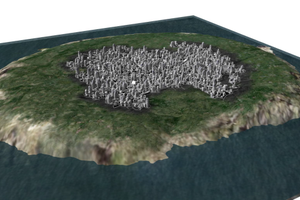要访问教程CityEngine中,单击 帮助>下载教程和例子…。选择教程或示例后,项目会自动下载并添加到您的工作区。
本教程展示了如何将 CGA 报告变量与基于 Python 的导出器结合使用。我们将报告分布在我们场景中的实例的信息,并使用它在一个简单的文本文件中生成一个实例映射。
有关 CityEngine 特定 Python 命令集的更多信息,请参见 CityEngine 帮助:帮助>帮助内容>手册> Python 脚本。

笔记:
Python 脚本接口并非在所有 CityEngine 版本中都可用。
第 1 部分:实例化建筑物的报告信息
在第一部分中,我们将使用现有的 CGA 文件,该文件在我们的场景中分布实例化建筑物,并添加报告变量以准备用于第 2 部分中基于脚本的导出器的实例的附加信息。
本教程需要 CGA Shape Grammar 的基本知识以及 Scripting API 的基础知识。
使用基于脚本的导出器
基于脚本的导出器基本上是一个通过导出触发的 CGA 生成过程。在导出设置中设置并在导出/生成过程中运行的 Python 脚本可以在生成期间和生成之后处理每个模型。
在这个例子中,我们将:
- 准备报告所需值的 CGA 命令。
- 为每个生成的模型查询 CGA 规则中报告的值。
- 生成所有模型后,将收集的报告值写入一个文本文件。
目标
我们想写出一个包含必要数据的文本文件,以便能够在任意后续应用程序中加载分布式建筑实例。
对于每个实例,应写入以下值:
- 资产标识符
- 3轴位置
- 3轴旋转
- 3轴缩放
采用以下形式:
| nr | 资产 | xpos | xrot | 比例尺 |
|---|---|---|---|---|
|
0 |
scifi_building_9.obj |
-529.4803009 |
0 |
1.051229466 |
|
1 |
scifi_building_17.obj |
236.6141357 |
0 |
0.933861537 |
|
2 |
scifi_building_5.obj |
499.4240112 |
0 |
1.256899709 |
教程设置
- 将项目Tutorial_12_Scripted_Report_Export导入您的 CityEngine 工作区。
- 打开场景Tutorial_12_Scripted_Report_Export/scenes/reportInstances_01.cej。
在外部 CGA 文件中准备通用报告规则
尽管我们可以直接在 CGA 文件instance_city_01.cga 中添加所有必要的报告命令,但我们将编写一个具有通用报告规则的外部 CGA 文件。这样,我们将能够对任意 CGA 文件使用报告规则。
- 创建一个新的规则文件File > New … > CityEngine > CGA Rule File。
- 并将其命名为instanceReporting.cga。
创建一个新规则 InstanceReport。我们需要一个规则参数资产才能报告资产标识符。
InstanceReport(asset) -->
报告转换数据
资产标识符
我们简单地报告规则参数资产。
## report asset identifier
report("asset", asset)规模
在大多数情况下,需要相对于原始资产大小的比例。因此,我们不能仅报告范围大小,而需要将其除以资产大小。可以使用assetInfo()命令查询原始资产大小。assetInfo(asset, “sx”)查询 x 轴的大小。
因此,规模的报告命令是:
## report scale values relative to asset
report("xscale", scope.sx/assetInfo(asset, "sx"))
report("yscale", scope.sy/assetInfo(asset, "sy"))
report("zscale", scope.sz/assetInfo(asset, "sz"))回转
我们要报告世界坐标中的旋转,因此需要使用 convert() 命令在 CityEngine 中转换枢轴旋转:
## report rotation in world coords
report("xrot", convert(x, pivot, world, orient, 0,0,0))
report("yrot", convert(y, pivot, world, orient, 0,0,0))
report("zrot", convert(z, pivot, world, orient, 0,0,0))位置
位置是最棘手的部分。为了能够在后续应用程序中正确地实例化您的资产,重要的是要注意所用资产的枢轴和位置。在我们的例子中,资产的支点位于地平面上的中心,并位于世界原点。请参阅下面的 Maya 屏幕截图以进行说明:

因此,在报告头寸之前,我们将按以下方式修改资产范围:范围被缩放为一个小“针”,并以 x 和 z 为中心。通过这种方式,我们确保报告的位置对应于 Maya 中资产的枢轴。
## scale and center scope
s(0.0001,'1,0.0001) center(xz)同样,位置需要转换为世界坐标:
## report position in world coords
report("xpos", convert(x, scope, world, pos, 0,0,0))
report("ypos", convert(y, scope, world, pos, 0,0,0))
report("zpos", convert(z, scope, world, pos, 0,0,0))我们现在已经报告了所有必需的值。为了确保视口中没有显示不需要的几何图形,我们在报告规则的末尾添加了一个 NIL 命令。最终报告规则:
InstanceReport(asset) -->
## report instance ID
report("asset", asset)
## report scale values relative to asset
report("xscale", scope.sx/assetInfo(asset, "sx"))
report("yscale", scope.sy/assetInfo(asset, "sy"))
report("zscale", scope.sz/assetInfo(asset, "sz"))
## report rotation in world coords
report("xrot", convert(x, pivot, world, orient, 0,0,0))
report("yrot", convert(y, pivot, world, orient, 0,0,0))
report("zrot", convert(z, pivot, world, orient, 0,0,0))
## scale and center scope
s(0.001,'1,0.001) center(xz)
## report position in world coords
report("xpos", convert(x, scope, world, pos, 0,0,0))
report("ypos", convert(y, scope, world, pos, 0,0,0))
report("zpos", convert(z, scope, world, pos, 0,0,0))
NIL使用报告规则
让我们回到原始 CGA 规则文件并使用准备好的报告规则。在文件instance_city_01.cga的开头,添加以下行以导入 ID 为instanceReporting的准备好的报告规则文件。
import instanceReporting:"instanceReporting.cga"现在我们只需将 InstanceReport 规则添加到构建规则的末尾。确保还添加叶规则“资产”。在插入命令之后以确保生成资产。
Building(asset) -->
s('1,0,'1)
i(asset) Asset.
instanceReporting.InstanceReport(asset)现在生成一个建筑物,然后查看 Inspector 的 Reports 窗格,它应该类似于:

笔记:
Inspector 中的 Reports 窗格仅用于统计报告,并不显示所有值(例如不显示字符串)。但是,在我们的案例中可以使用它来确保报告所有必需的值。
第 2 部分:导出脚本
我们现在将使用基于脚本的导出器处理准备好的报告数据。为此,我们需要创建一个新的 Python 脚本来完成这项工作。
Python 脚本导出模板
- 从模板File > New … > Python > Python Module创建一个新的 python 导出脚本。
- 选择项目的脚本文件夹,将其命名为 exportInstances 并选择 Module:Export (Reporting) as template。

模板脚本包含四个函数。我们只需要finishModel()和finishExport(),所以删除另外两个。
在 finishModel() 中访问报告数据
可以通过以下方式访问当前处理形状的报表变量数组:
model.getReports()['asset']其中资产是报告变量的名称。
因为并非所有生成的形状都有一个实例(例如空的地面形状或街道形状),我们首先需要使用报告变量之一检查报告数据的存在,即“资产”:
if(model.getReports().has_key('asset')):如果您详细查看生成的建筑物的 CGA 规则,您会注意到某些形状包含多个实例。因此,我们需要首先获取“资产”数组的长度,遍历每个形状的所有报告数据集。作为第一个测试,我们将报告数据数组打印到控制台:
l = len(model.getReports()['asset'])
for i in range(0,l):
print model.getReports()运行基于脚本的导出器
- 选择一小组建筑物或地块形状
- 启动基于脚本的导出器:文件>导出 … > CityEngine >导出选定形状的模型,然后选择基于脚本的导出器 (Python)
- 在杂项。Options 选项卡,浏览到导出脚本 exportInstances.py并通过单击Finish运行导出器。

Python 控制台输出应读取以下形式的内容:
{‘zpos’:[-362.6108093261719],’yrot’:[-69.42008209228516],’资产’:…
{‘zpos’:[-412.1033630371094],’yrot’:[165.30718994140625],’资产’:…
…
笔记:
Python 输出控制台可以通过 Menu Window > Show Console打开。
使用工具栏上的控制台开关下拉菜单选择输出控制台。
添加全局变量
我们现在没有将数据打印到控制台,而是添加一个新函数 processInstance() 来处理和收集报告值。此外,我们添加了两个全局变量(在完成模型函数之外),用于收集数据并跟踪实例计数:
# Globals
gInstanceData = "" # global string that collects all data to be written
gInstanceCount = 0 # global count to enumerate all instancesfinishModel() 函数
完成的函数finishModel():
# Called for each initial shape after generation.
def finishModel(exportContextOID, initialShapeOID, modelOID):
global gInstanceData, gInstanceCount
model = Model(modelOID)
if(model.getReports().has_key('asset')): # only write t3d entry if report data available
# there might be more than one asset per model, therefore loop
l = len(model.getReports()['asset'])
for i in range(0,l):
instanceData = processInstance(model.getReports(),gInstanceCount, i-1)
gInstanceData = gInstanceData+instanceData
gInstanceCount = gInstanceCount+1processInstance() 函数
此函数仅以制表符分隔的字符串形式返回所有报告变量:
''' Collect the instance information in a tab-separated string'''
def processInstance(reports, count, index):
## remove path from asset string
asset = reports['asset'][index]
asset = asset.rpartition("/")[2]
## prepare the string for the instance map
text = "%dt" % count;
text += "%st" % asset;
text += "%.3ft%.3ft%.3ft" % (reports['xpos'][index],reports['ypos'][index], reports['zpos'][index])
text += "%.3ft%.3ft%.3ft" % (reports['xrot'][index],reports['yrot'][index], reports['zrot'][index])
text += "%.3ft%.3ft%.3fn" % (reports['xscale'][index], reports['yscale'][index], reports['zscale'][index])
return textFinishExport() 函数
在所有形状生成完成后调用此函数。我们在这里定义包含实例映射的文本文件的文件名,并调用 writeFile() 函数:
# Called after all initial shapes are generated.
def finishExport(exportContextOID):
global gInstanceData, gInstanceCount
## path of the output file
file = ce.toFSPath("models")+"/instanceMap.txt"
## write collected data to file
writeFile(file, gInstanceData)
print str(gInstanceCount)+"instances written to "+file +"n"writeFile() 函数
… 添加标题信息并将收集到的报告字符串写入磁盘:
''' combining data (header and content) and writing file '''
def writeFile(file, content):
## prepare the head string
head = "nrtassettxpostypostzpostxrottyrottzrottxscaletyscaletzscalen"
## combine header and content
content = head + content
## write data to the file
report = open(file, "w")
report.write(content)
report.close()运行最终脚本
- 选择一组建筑物或地块形状。
- 启动基于脚本的导出器:File > Export … > CityEngine > Export Models of selected Shapes并选择Script Based Exporter (Python)。
- 在杂项。Options 选项卡,浏览到导出脚本exportInstances.py并通过单击Finish运行导出器。
生成的文件 instanceMap.txt 保存在当前项目的模型目录中。
nr 资产 xpos xrot 比例尺 0
scifi_building_9.obj
-529.4803009
0
1.051229466
1
scifi_building_17.obj
236.6141357
0
0.933861537
2
scifi_building_5.obj
499.4240112
0
1.256899709
您可以以任意方式处理报告的数据,而不是编写制表符分隔的文本文件:例如,为创建实例的 Maya 编写 Mel 脚本、将位置信息写入数据库或编写基于 ASCII 的自定义格式。
第 3 部分:附加元素
多亏了通用报告规则,我们现在可以使用额外的实例元素轻松扩展我们的 CGA 规则集以进行报告和导出。
- 将instance_city_02.cga分配给场景中的所有形状。
- 生成一些街道形状
此规则文件包括街道上的未来弧形元素。


打开 CGA 规则文件instance_city_02.cga。
使用报告规则
为了将网桥实例也导出到 instanceMap,只需将 InstanceReport 规则添加到网桥规则即可。
Bridge -->
s(1,8,scope.sz+3.2) center(xz)
i(bridge_asset)
s(calcHeight2(scope.sx),calcHeight2(scope.sy),'1)
Bridge.
instanceReporting.InstanceReport(bridge_asset)| nr | 资产 | xpos | … |
|---|---|---|---|
|
0 |
桥接3.obj |
-363.586952209 |
… |
|
1 |
桥接3.obj |
-313.587295532 |
… |
|
… |





